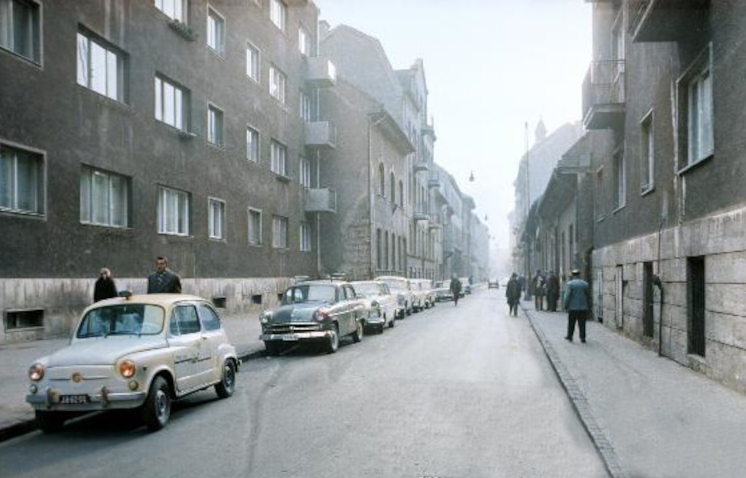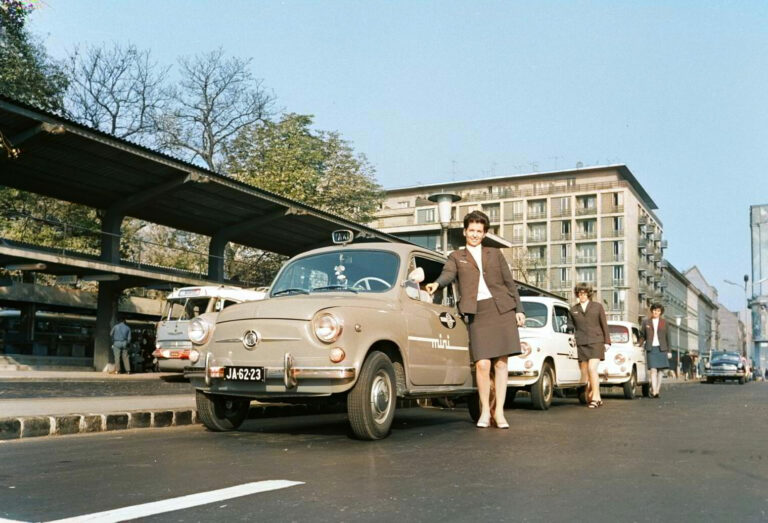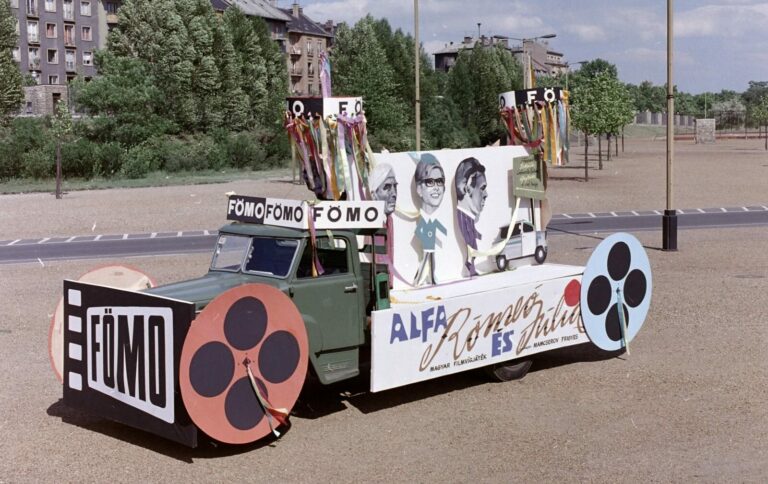1951 - For your own good, for the good of your country:
Make a note of peace!
... proclaims the front page of Autó-Motor of 1 October 1951. In the background is the "Autóváros", one of the first completed social-real residential buildings of the József Attila estate in Inselszentmiklós, which later became - and still stands today - a József Attila estate, and in the foreground is the carefully assembled 350, the original József Attila, trying to emphasise the call.
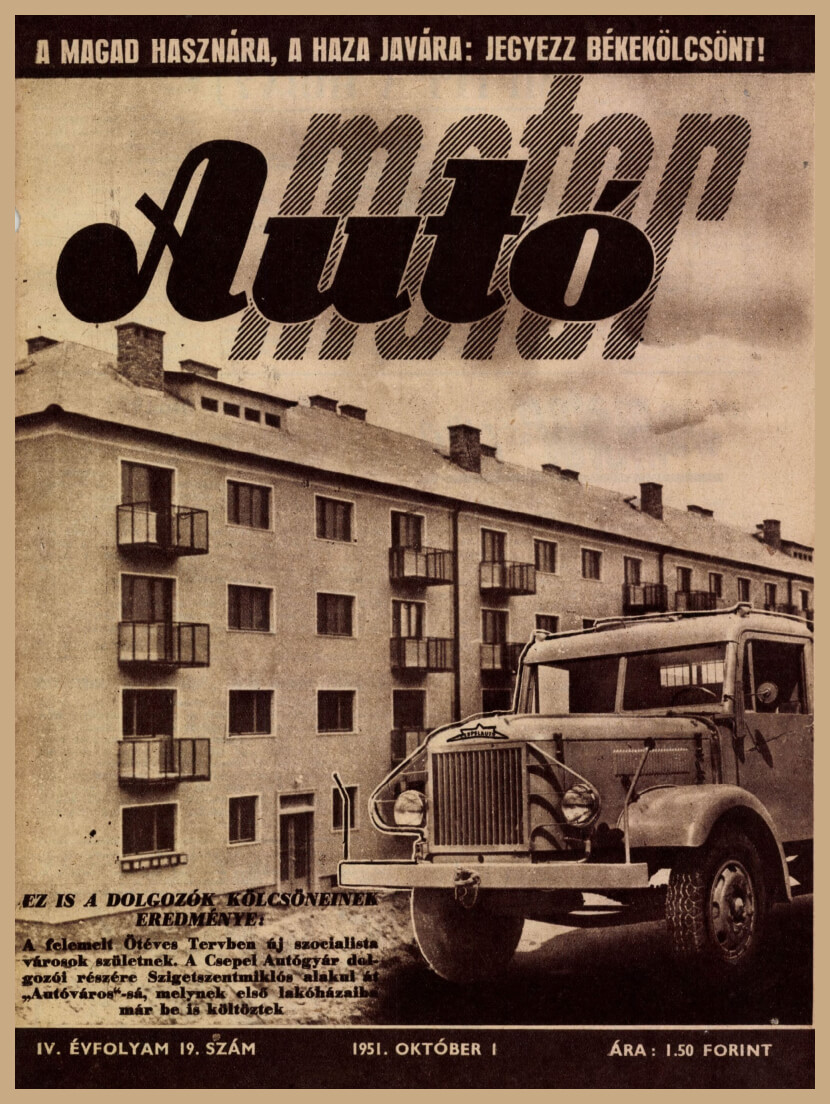
Image source: arcanum / Autó-Motor, 1951
For those who might not have found the offer convincing enough at first, the third page of the newspaper contains a report, richly illustrated with photos, about the good news for the workers of the Car Repair III: "...the workers of the Repair III, who have subscribed to about 250,000 HUF in nominal value from the Plan and Peace Loans, ...have already received 3 million HUF for the development of the plant and social institutions.
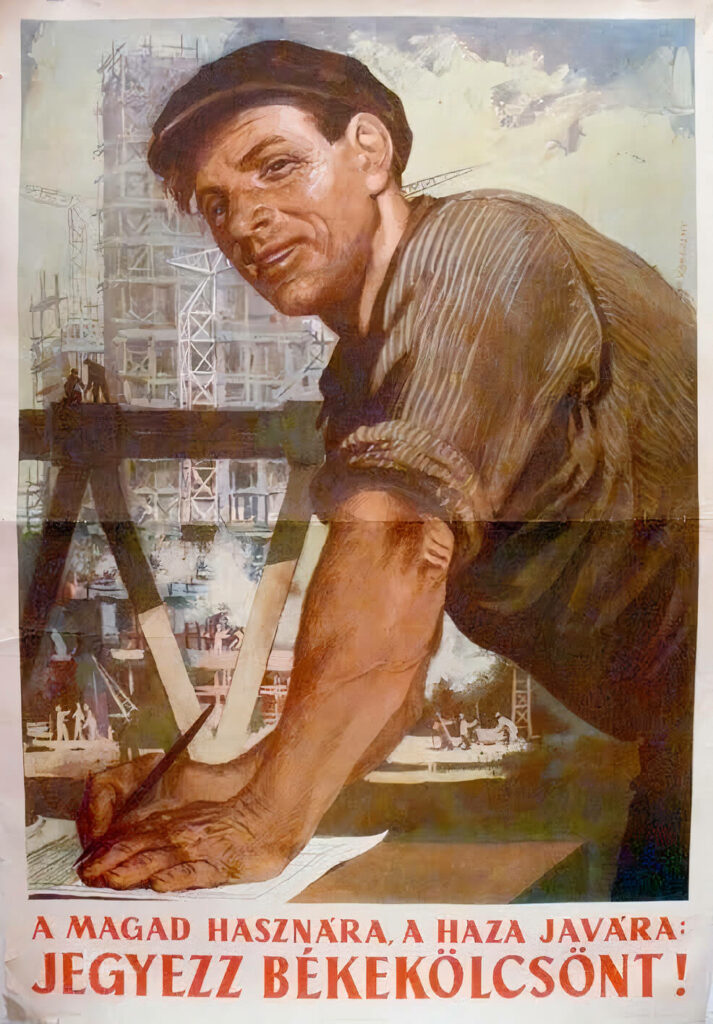
The work of György Konecsni - Image source: hogyantortent.com
But what was the plan and the peace agreement?
On 1 August 1947, the National Planning Office published the three-year economic plan of Hungary in the Hungarian Gazette in accordance with the provisions of Act XVII of 1947, § 3, paragraph ". In addition to the ambitious investment plan figures, the source from the "Plan Loan" was already included as a separate budget item for the entire three years, as a revenue plan of 860 million euros.
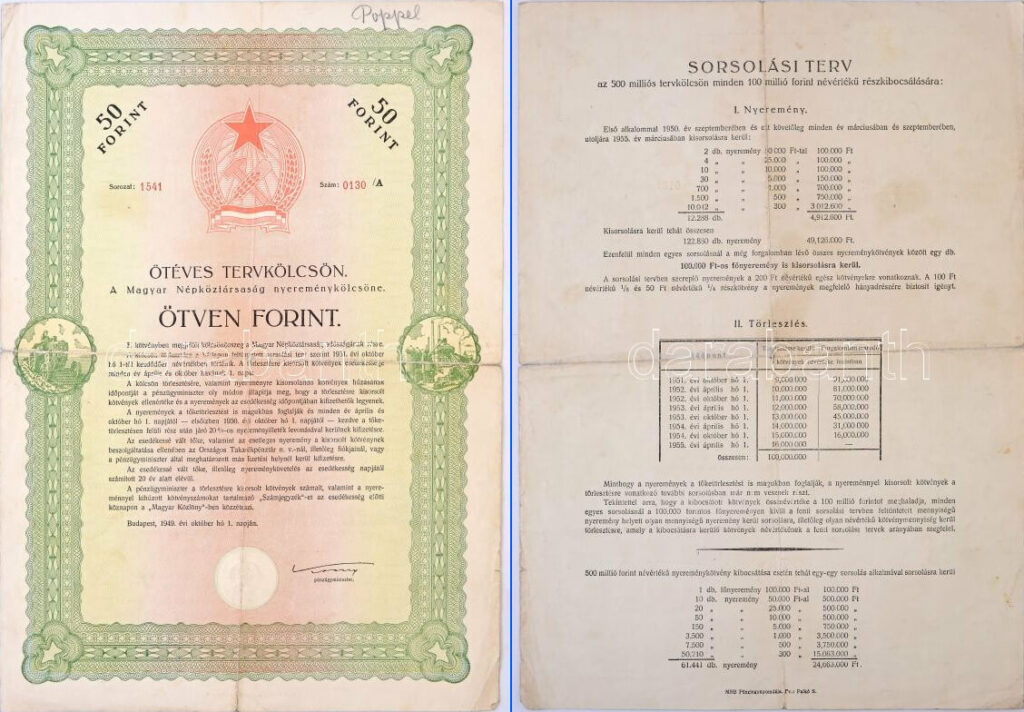
Image source: darabanth.hu
This three-year plan was completed in less than two and a half years, if true - or if they were just trying to make the new plan fit the calendar year - but the fact is that the closing date is 31 December 1949. From 1950, the plan period was restarted as a five-year period and the "plan loan" became the "Peace Loan" in the new baptism.
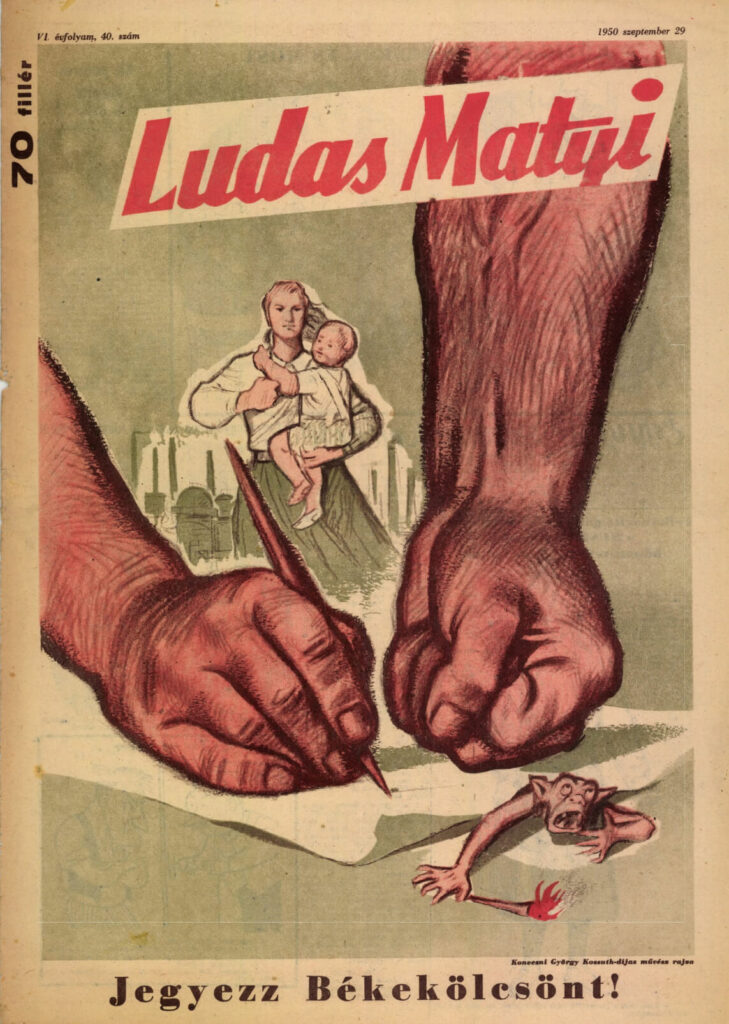
Source: Arcanum / Ludas Matyi 1950
In fact, after the Second World War, reconstruction and reparations obligations placed an almost unbearable financial burden on Hungarian governments. The communist takeover of 1948-1949 - and the simultaneous adoption of the Soviet model of economic management - added to the problems: huge investments were planned and launched, resulting in a constant shortage of resources.
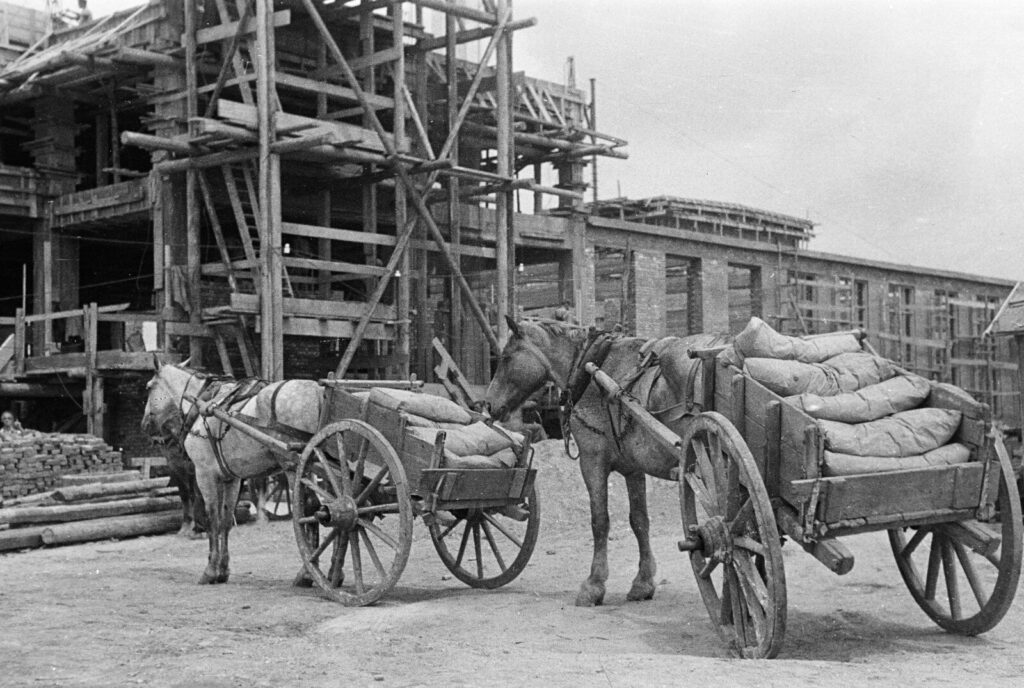
Hungary, 1950, Dunaújváros (Dunapentele), taken at the beginning of the construction of the industrial town. - Image source.
As today, they tried to plug the budget holes by raising 'external' capital. The solution was the introduction of the Plan Loan (1949) and the Peace Loan (from 1950), which placed a further heavy burden on the population.
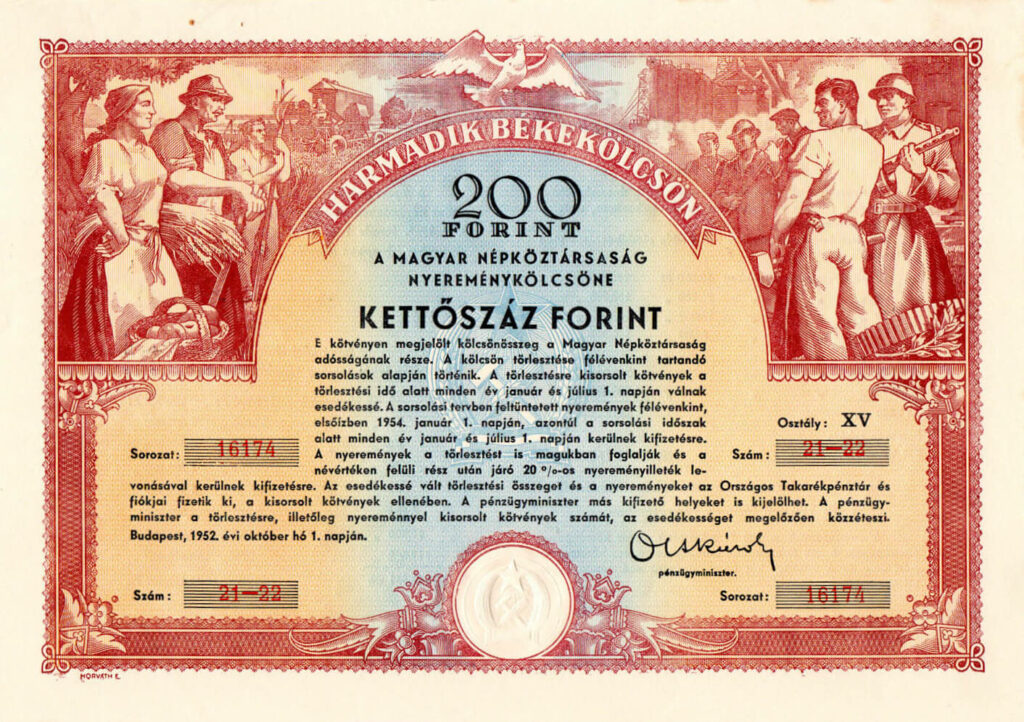
Image source: m.eremshop.hu
The desired amount of the subscription could only be forced. When the peace loan was first issued, the government laid down in a detailed decree the obligations of employers in this respect, from signing the instalment slips to deducting the amount subscribed in instalments. In general, the employer has become responsible for all loan subscription matters. 'If the employer fails to pay the instalments due, the OTP is entitled to take measures to recover the arrears by means of a levy in accordance with Decree No 200/1950 (VIII.6) of the Labour Code.' Even if the compulsory nature of the peace loan was not stated, it was clear that the employer was given a quasi-authoritative role.
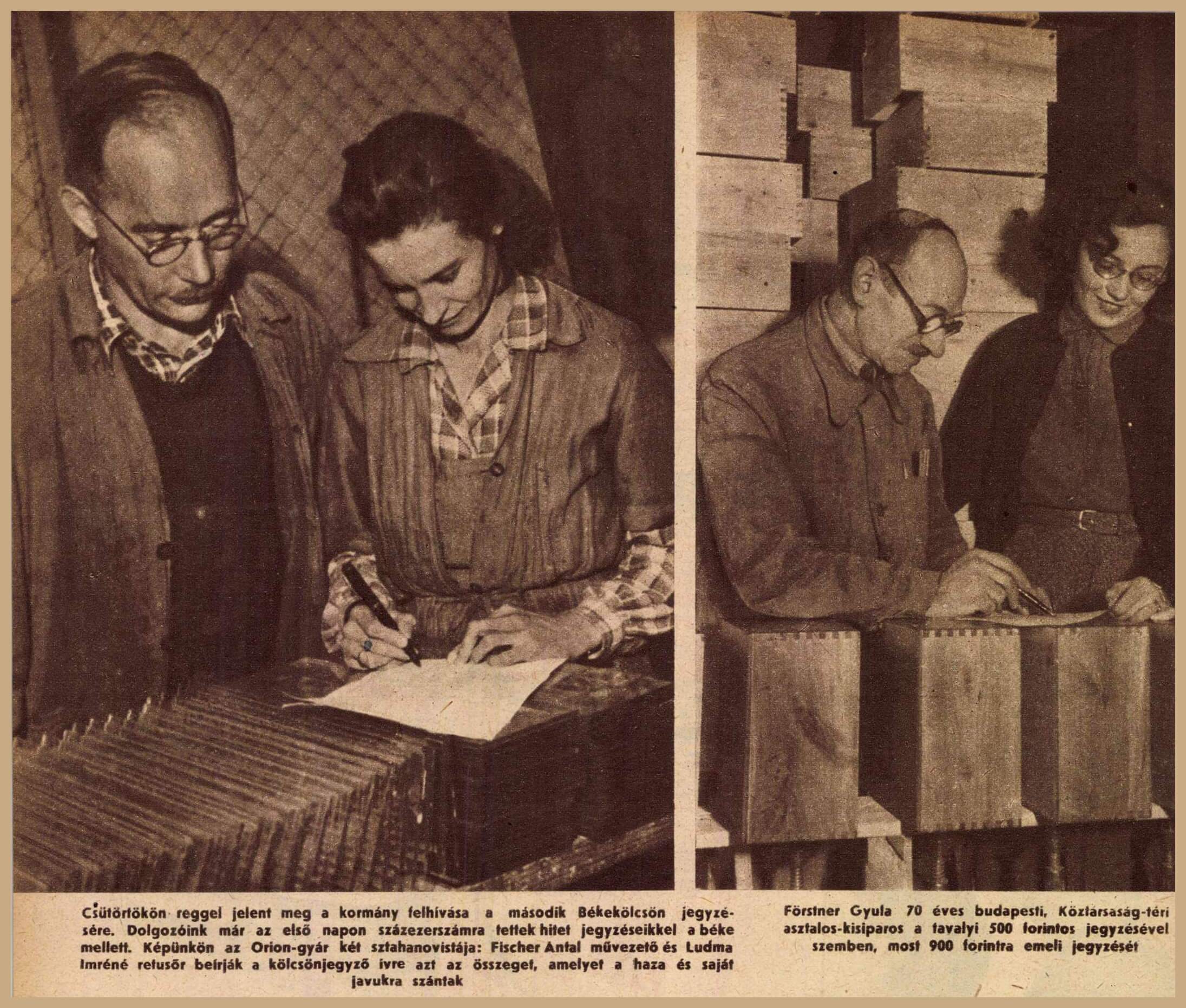
In addition to pressure, propaganda was also carried to its peak in the press of the time - Image source: Arcanum / Peace and Freedom Journal, 1 Oct 1951
The amount offered for each individual subscription was set by the management, the company party organisations and the trade union (triangle). Although subscription was voluntary in principle, a legal basis was created for the political stigmatisation and severe punishment of any dissent.
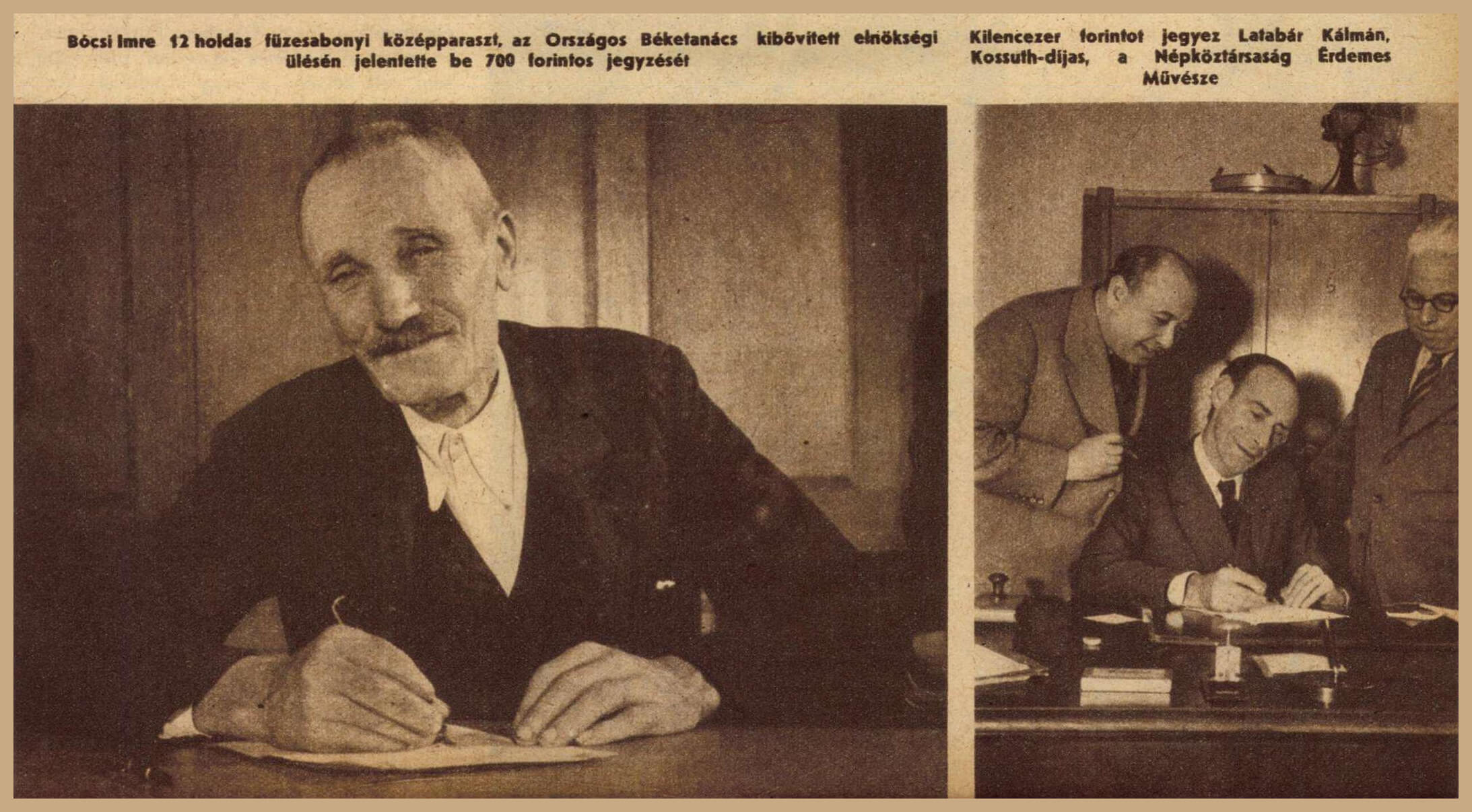
The 12-acre middleground, and the Kossuth Prize-winning Kálmán Latabár among the notaries - Image source: Arcanum / Peace and Freedom Journal, 1 Oct 1951
From 28 September 1950 to 27 September 1955, the government loan bonds called the Peace Loan were issued in September and October each year. The National Savings Bank was responsible for the loan.
Initially, the bonds could be either interest-bearing or profit bonds, but the third and subsequent peace warrants were issued only in the latter type.
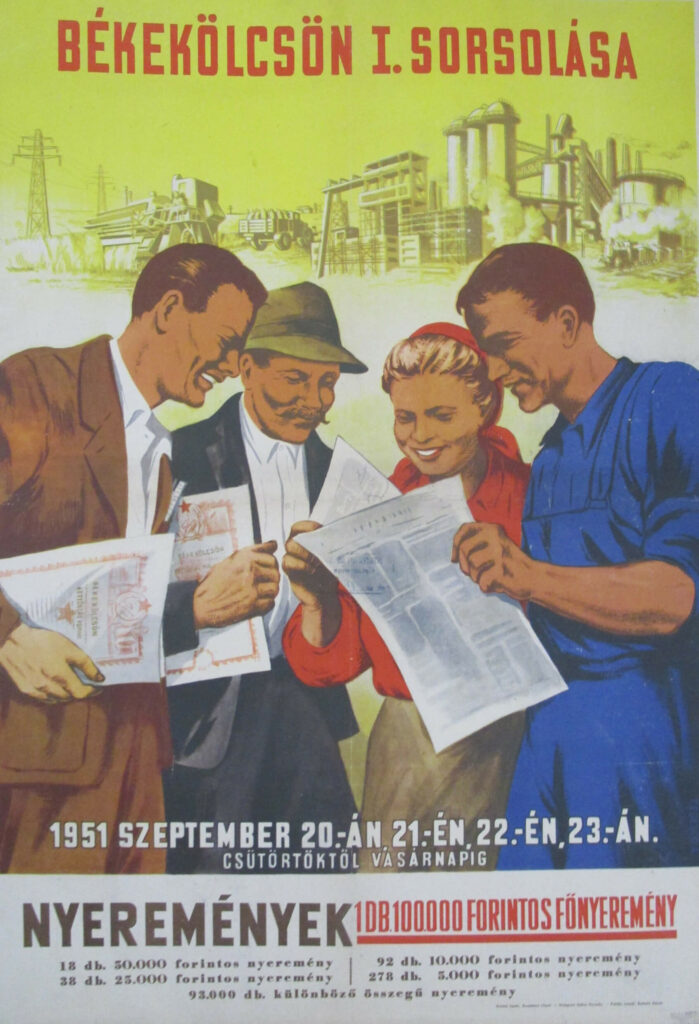
Image source: muzeum.pesterzsebet.hu
On the interest-bearing loans, the State paid interest of €51T3T per year until the date of repayment. The prize bonds were entered into a draw every six months, with prizes ranging from HUF 200 to HUF 100 000. Bonds not drawn with prizes were redeemed at par over the redemption period set at the time of issue, i.e. 10, 15 or 20 years.
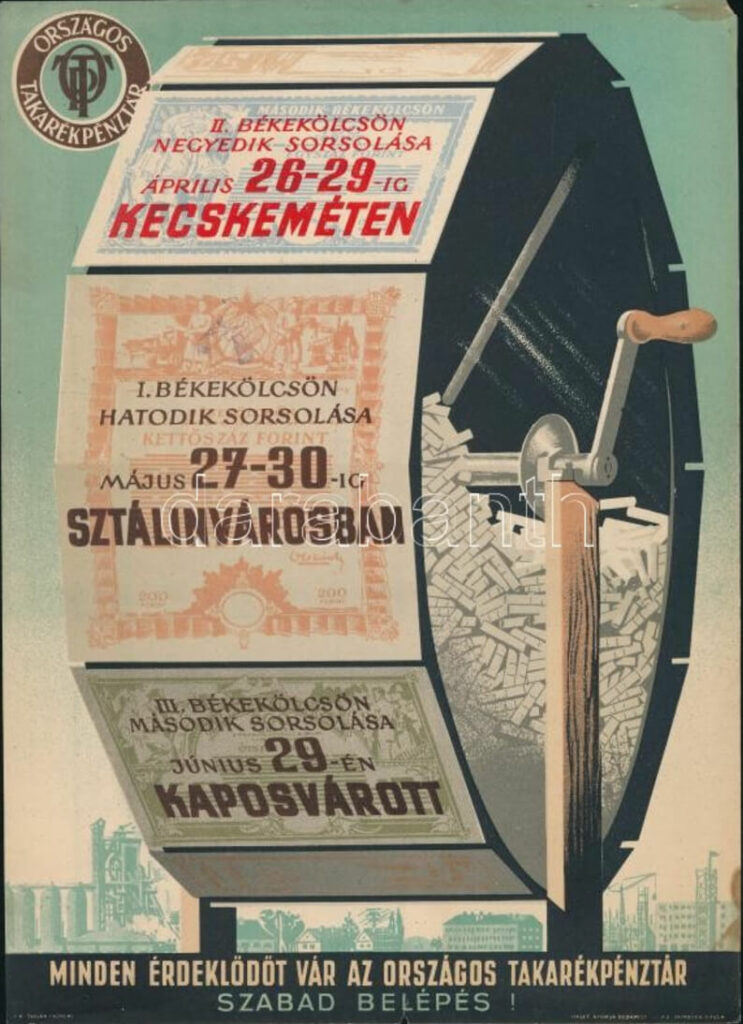
Image source: darabanth.hu
The bearer bonds were usually issued in 100 HUF denominations, but there were also 200 and 500 HUF bonds, and 50 and 25 HUF half and quarter bonds for interim settlement.
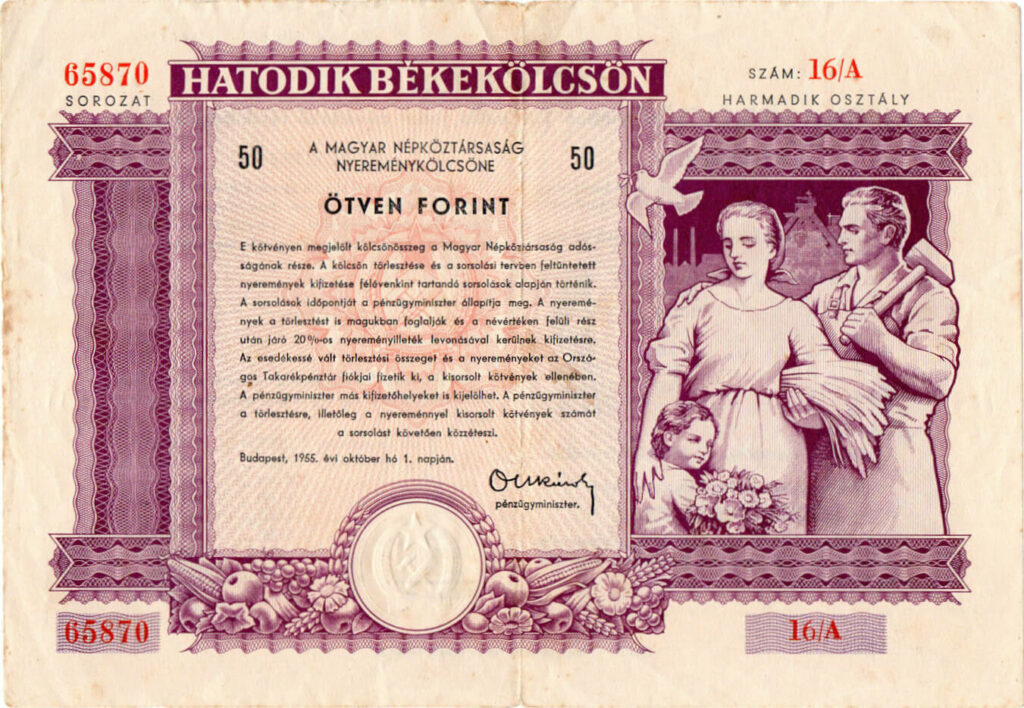
Image source: m.eremshop.hu
The loan amount could be subscribed by the population in cash or by instalments from their income. The local councils were responsible for cash payments, and the employer deducted the amount subscribed from employed workers and members of small cooperatives (and pensioners) over a 10-month period.
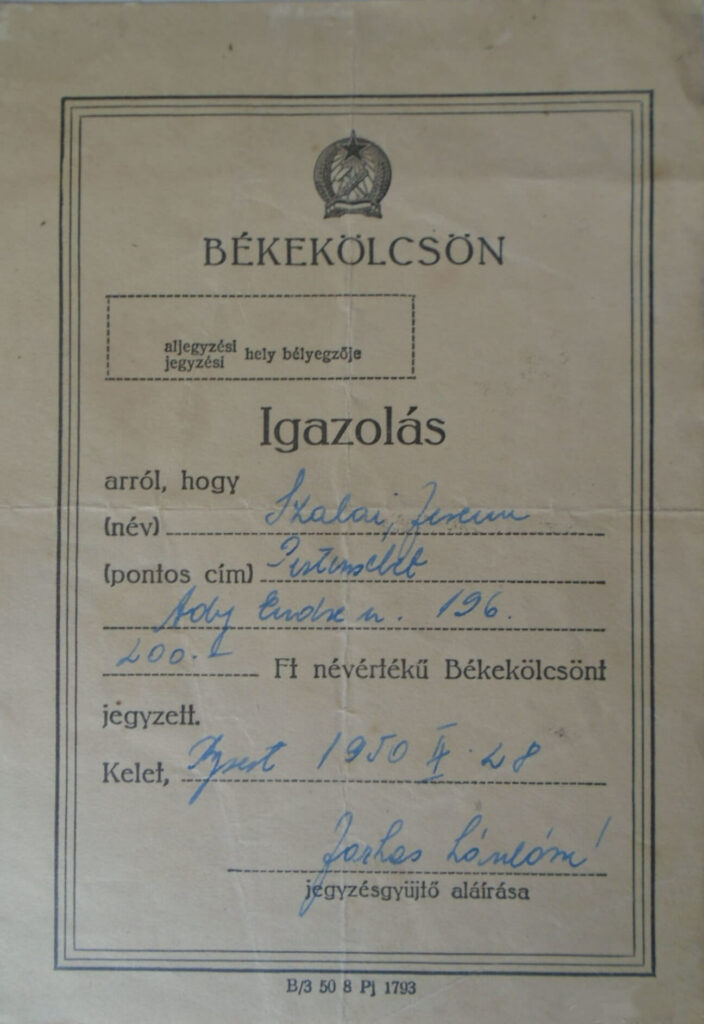
Image source: gallery Savaria
They used a variety of means of persuasion and propaganda. In some companies, the names of the workers were read out over a loudspeaker, the amount of their monthly earnings and a proposal for the amount of the subscription. Others were told by popular educationists that subscriptions were a "patriotic duty", "for the strengthening of our country and the defence of our peace".
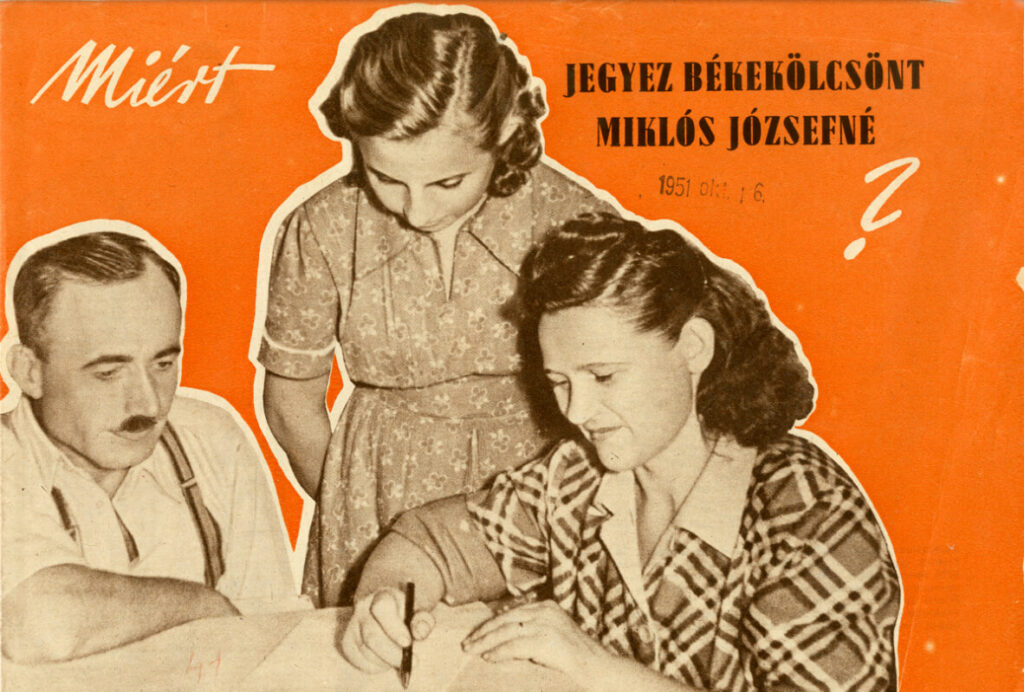
Propaganda leaflet from 1951 – Image source: www.europeana.eu / National Széchényi Library
The fourth, fifth and sixth peace vouchers were issued directly for the development of investments to improve living standards - light industry, food and agriculture - and to increase the interest, 25 and then 50% of the subscriptions collected by the councils could be used by the municipality concerned for social or cultural purposes.
In general, a quarter of the revenues from the public came from state loans, with some HUF 7 billion being subscribed by the people "for the benefit of the country" over the seven years.
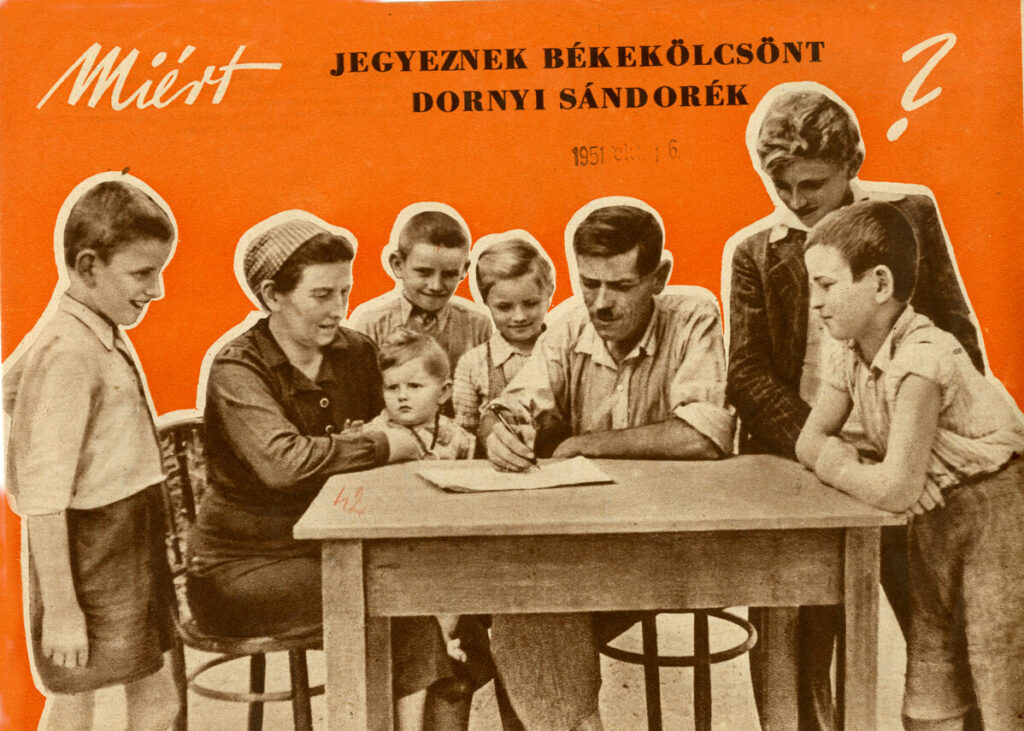
Propaganda publication from 1951 - Image source: www.europeana.eu / National Széchényi Library
Issuing more and more bonds became a permanent instrument of economic policy.In September 1955, the country was already at the stage of the VI Peace Loan. The Council of Ministers' call for subscriptions, referring to the fact that the 1949 plan loan had been repaid in full, used the propaganda elements of the time to encourage the subscription of the new security:
"The sum subscribed to the Sixth Peace Loan is intended to further strengthen the power of the working class, to develop heavy industry and agriculture, to increase the prosperity of our people, to further our rise, to promote peace.
The fervent patriotism of our people and their growing political consciousness are a guarantee that all honest Hungarian workers who love their country, their people and their families will participate in the loan.
HUNGARIAN WORKERS! WORKERS! PARASTS! REALISERS! For the benefit of the homeland, for your own benefit, make a note of PEACE!"
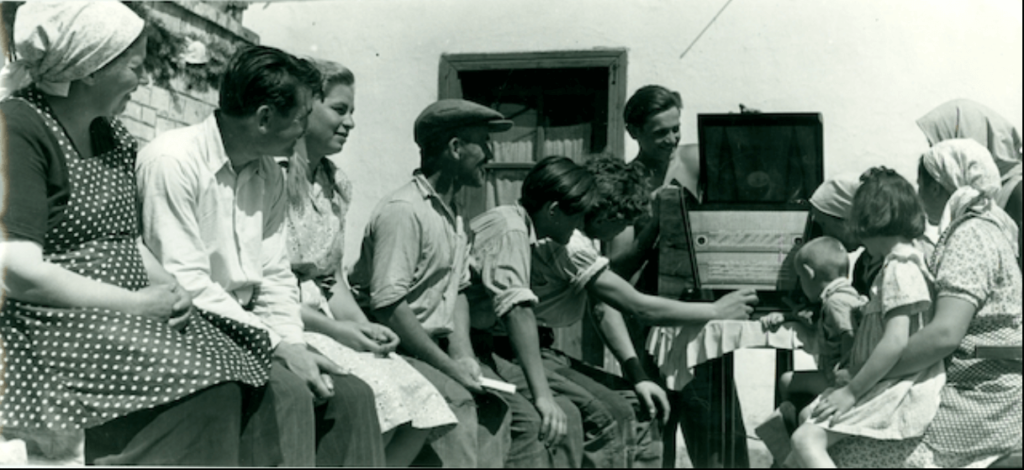
Men and women listen to the first peace prize draw on the radio. - Image source: europeana.eu / Hungarian National Museum
1956 - among many other things - swept away the Peace Coin, after which there was no new subscription. Repayments were also suspended, and repayments were not made until much later than originally promised.
🍀
On 17 January 1957, the Minister of Finance entrusted the National Savings Bank with the organisation of the Hungarian lottery by Decree No. 4/1957. According to the regulations, bettors receive a prize for 2, 3, 4 or 5 hits out of a total of 90 numbers drawn.
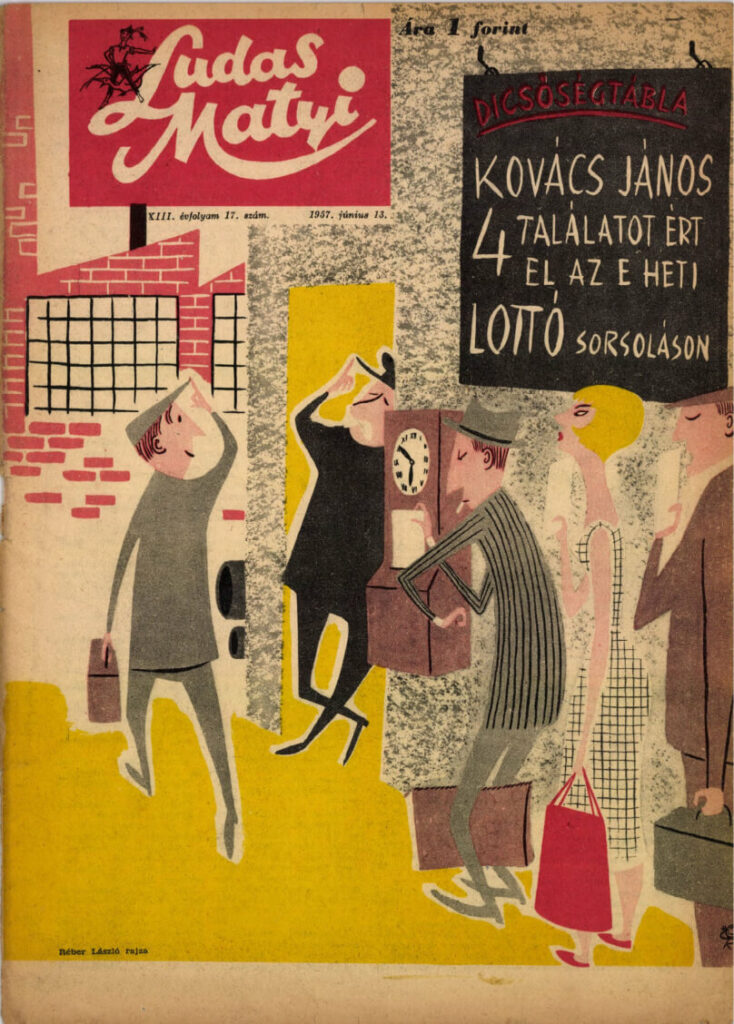
Source: Arcanum / Laudas Matyi, 1957
40% of the proceeds went directly to the state budget and 60% to the prize fund
The first draw was held on 7 March 1957.
Coincidence? Hardly.
🍀
